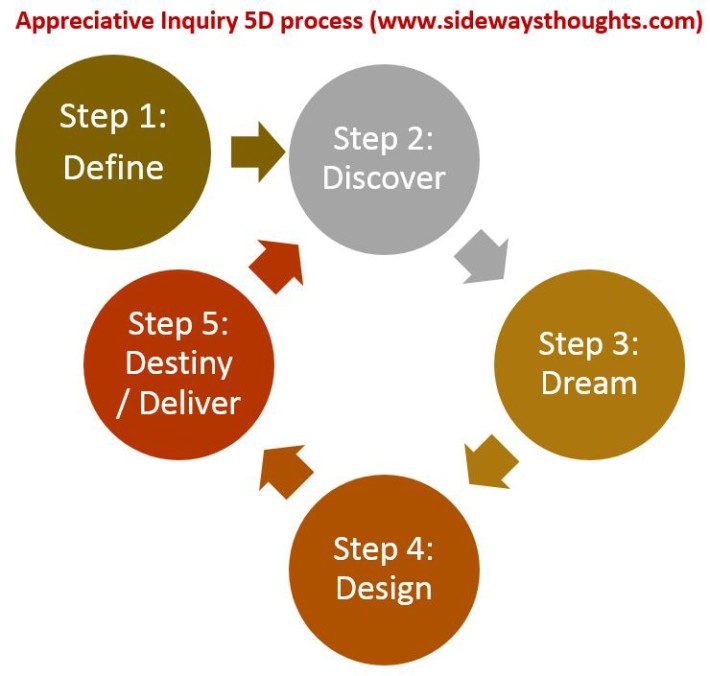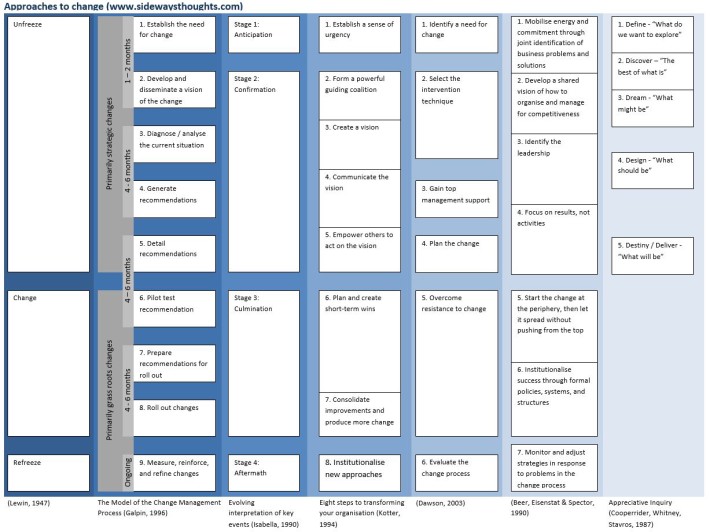Change your frame of reference with the Appreciative Inquiry 5D process

There are in general two perspectives to most things in life. Take, for instance, writing a blog post about the Appreciative Inquiry change process. One way to write the post is to talk about how traditional approaches to change start with a problem. The blog post could launch into how a typical problem-solution model frames organisations, situations, and people as being broken and in need of fixing. The post then goes on to articulate how Appreciative Inquiry is better by focusing energy on “what could be” rather than on “what isn’t”.
I have started that post about a dozen times. In the post, I reinforce what I have said previously about psychological motivations that underpin Appreciative Inquiry’s eight principles. I share my experience using Appreciative Inquiry techniques in facilitation to help teams overcome issues and define and achieve their goals. I create a compelling argument to solve the problem of a broken change process.
Except I am having difficulty finishing that blog post, as I keep tripping over irony. The irony with such a post is that I am framing the approach as a problem. Even knowing what I know about the benefits of Appreciative Inquiry starting with the best that is, I am still inclined to frame the case for Appreciative Inquiry using the magnitude of the negative situation to justify the positive direction.
So I started to consider the second way to write the blog post. In this alternative way, I make the case for everything that we do well in our change processes; what inspires us personally and in our teams. I then talk about everything we hope for in a change process, what makes us feel most rewarded and alive. I go on to share different elements that make a change process reflect that perfect future vision, Finally, I propose some ways in which those elements could become a reality. Following this format, I am applying the Appreciative Inquiry five-step process to itself.
These two perspectives are often framed using a metaphor of a burning platform and a burning ambition. Peter Fuda speaks about these two perspectives in his clever video below:
To write the second blog post, I need to change the way I approach change, from that of a burning platform approach to consider instead a burning ambition. I can only do this if I am mindful and intentional about changing my approach to change. To do this, it is helpful to understand where Appreciative Inquiry sits in relation to other change processes.
How we change
A while back I compared several approaches to change that use what David Collins’ refers to as “n-step” models. These models prescribe a series of mostly linear steps or stages to effect change. At the time, I joined Collins in his frustration with the gap between what can be seen as simplistic and unrealistic models. My personal reaction to research that shows 70 percent change failure rates led me to embrace notions such as complex adaptive systems and chaos theory. I then pursued a more holistic approach that focused on defining the meaning behind change rather than a focus on the discrete outputs of the change process.
Frustration, however, can be tiring without an alternative approach. I see Appreciative Inquiry as that alternative process that bridges the gap between two extremes. On the one side you have prescribed linear step-by-step approaches to solving problems, an approach that assumes we are rational actors in a stable environment. On the other side there can feelings of lack of control, as though you give in to the chaos and accept that whatever will be, will be.
Using the previous metaphor, Appreciative Inquiry creates a solid foundation onto which people can individually and collaboratively discover and realise their burning ambitions. It is not that problems are not raised in Appreciative Inquiry, but that a safe environment is created for the problems to be worked through towards the positive end.
As an example, Gervase Bushe writes about his work with Frog Hollow Neighbourhood House in Vancouver, Canada. Sharing stories in the Appreciative Inquiry Discover phase led to a safe environment for people to share what could be perceived as “negative” emotions, prompting the facilitators to ensure they had mental health professionals they could refer participants to. Yet the overall exercise was perceived as positive to the extent that over 2,000 people participated in the voluntary groups over ten months.
The safe environment Bushe speaks about is created through Appreciative Inquiry’s five step process, otherwise known as the 5Ds:

- Step 1: Define – “What do we want to explore”
Create the topic to focus the conversation, framed without value or judgement. - Step 2: Discover – “The best of what is”
A series of questions to identify the individual and collective “positive core”, identifying the best of what is and what can be carried forward into the future. - Step 3: Dream – “What might be”
Questions and activities to express and expose hopes and dreams of the future, encouraging participation, where each person can place themselves in the future state and feel what it is like to behave “as if” the changes are already in place. - Step 4: Design – “What should be”
Identify what each element of the future state looks like, asking questions around elements such as people, relationships, culture, systems and structure. - Step 5: Destiny / Deliver – “What will be”
Collaboratively create action plans within each Design element to create the Dreamed future.
You will notice in the comparison below that Appreciative Inquiry’s 5D’s are not prescriptive about how the change is executed (click on the picture for a bigger view). The assumption is that going through the Appreciative Inquiry approach will reveal the best method of execution from the participants themselves.
Change the frame
I have been mindful of my body language as I wrote this post. I found myself frowning and tense when I focused on the challenges of traditional change process and reflecting on my own negative change experiences. Conversely, my mood lifted as I considered my positive experiences with change processes and the benefits of Appreciative Inquiry.
I am not saying everything has to be happy all the time. I have previously acknowledged how suffering can be necessary in achieving well-being. I do believe, however, in the opportunity presented by Appreciative Inquiry to re-frame our personal and organisational approaches to change towards a positive outcome. I know which path I would take if I had to choose between two states of being: focusing on solving problems or reflecting on what is positive, aspiring towards a positive future, and identifying the most effective path to get there.
I write these posts in part to become more intentional about taking a positive approach to change processes. It is also my hope that this will start a conversation you might have with yourself about how you approach change in your life and in the teams you work with.
I welcome your comments below if you have experience changing your frame, or if you are considering that perhaps a change of frame might be needed. I also welcome you to share through the social links below if you feel this might apply to others who could benefit from a perspective shift.
Now if you will excuse me, I should probably get on with writing that second blog post…



Dear Sir or Madam:
I am working for Development Innovations project. We are trying to innovate approach to solution to social issues in Cambodia. I am much interest to learn more about 5 D process which i think it is great tools for innovation things.
Could you share me your 5 D process curriculum?
I look forward to hearing from you.
My best,
lan
Hi Ian,
Thank you for your question. Have a look at the Appreciative Inquiry Commons: http://appreciativeinquiry.case.edu/
You can also find some thoughts on AI for not for profits here: http://boardseye.com/articles/_6
Those should provide you with some direction.
Chad